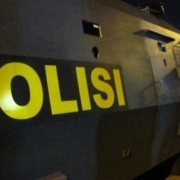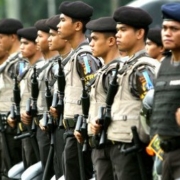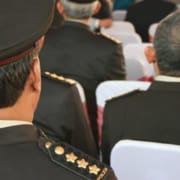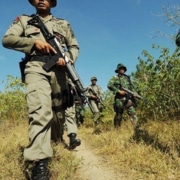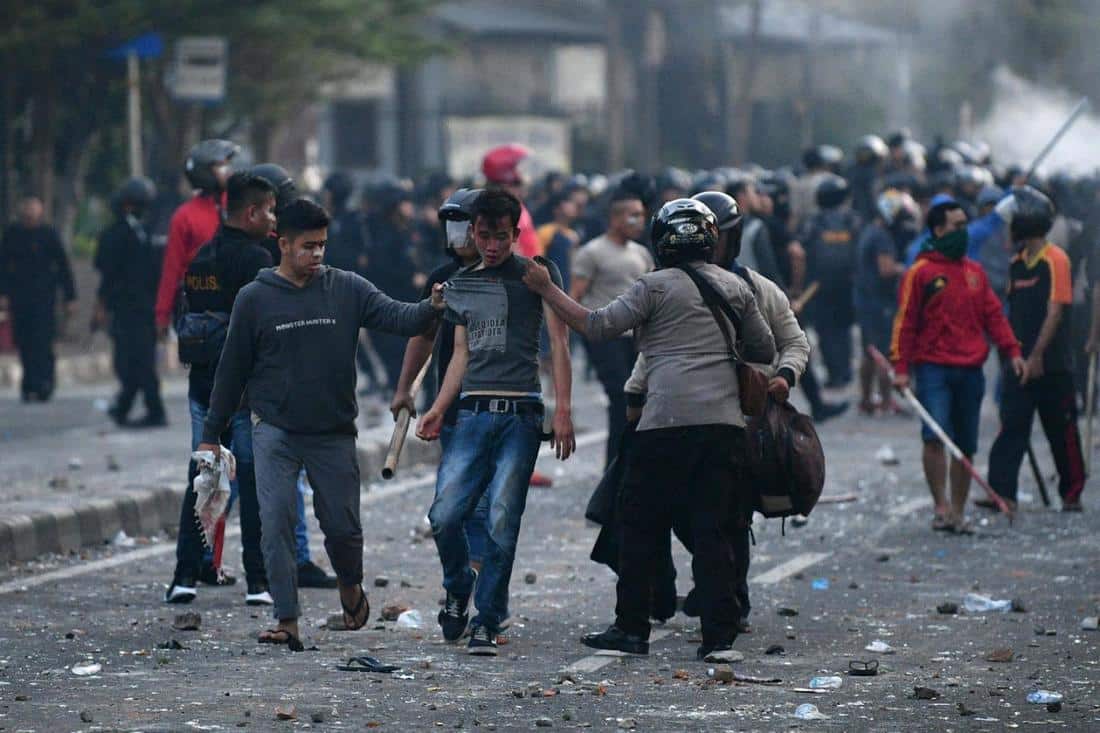
Police have painted the riots as being orchestrated by the political elite and the rioters as pawns manipulated by provocateurs. Photo by Sigid Kurniawan for Antara.
The riots in Jakarta from 21 to 23 May have left eight people dead, more than 700 injured, caused millions of dollars of economic losses, and resulted in at least 441 arrests.
Police have said that they have evidence that the most serious violence on 22 May was masterminded by certain groups, and have found firearms and rocks distributed in a Gerindra Party ambulance. National Police Chief Tito Karnavian has said rioters were brought in from Aceh, Tangerang and West Java to overthrow Indonesia’s government.
The police have painted the riots as being orchestrated by the political elite, and the rioters as pawns manipulated by provocateurs. While it is too early to know how much of this is true, this narrative ignores the social situation that had developed on the ground, which provided a fertile environment for the riots to escalate. Even without a push from elements of the elite or provocateurs, there were already significant preconditions for violence, and some of the important factors that created these preconditions were not related to electoral politics or religious sentiments.
I was present at the site of the riots on 23 May, and conducted interviews with residents and traders from Kemanggisan, Rawa Belong and Tanah Abang on 27, 28 and 29 May. This helped to provide a more complex picture of the riots than the police narrative.
While peaceful protests were initially triggered by the election results announcement, I believe the 22 May violence was also fuelled by two other factors yet to be highlighted in other analyses. The first is that it happened during Ramadan. The second is that economic activities in Tanah Abang were shut down for at least three days, depriving hundreds of informal sector workers and petty thugs of their usual sources of income.
Ramadan and the culture of street brawls in Jakarta
On Saturday 18 May, three days before the protests, Danu Tirta (16) died in Semanggi. About a week earlier, two other teenagers had also died. All three were from middle to lower income urban villages, or kampungs, and were victims of street brawls during “Sahur on the Road” (SOTR) activities.
During Ramadan in Jakarta, and indeed in many other cities in Indonesia, there is a long tradition of waking members of the community for the early morning meal before fasting, sahur. Participants, who are mostly local youths from working class families, sound drums and trumpets from about 2am to 4am. SOTR began as a charity-type activity, involving distribution of meals to the poor, and parents generally allowed their children to participate because it was considered an important cultural activity during Ramadan. It is unclear when SOTR became a source of violence.
But street brawls during sahur have now become common, and almost all Jakarta governors in recent memory have urged people not to participate in SOTR because of the potential for violence. Even without SOTR, however, street brawls have continued during sahur in many parts of Jakarta.
During Ramadan, it is common for young people head to the mosque for evening prayer, or tarawih, from about 7pm to 9pm. Many end up staying out all night. Despite the fact that the Jakarta government has stated that schools should continue to open at 6.30am during Ramadan, many schools still relax their hours, not expecting children to attend for the full school day. On 22-23 May, after the protests first began, many schools closed altogether. This made it easier for young people to join the riots.
Youth brawls are a longstanding problem in Jakarta and they are certainly not specific to Ramadan. But Ramadan created conditions for brawls to intensify at night and continue through to dawn.
As many media reports demonstrated, there was significant youth involvement in the May riots. For lower class kids in Jakarta kampungs, the motivation for participating in brawls can be as simple as a “fun” thing to do with their peers. More often it is a way to increase rank and respect within their peer group. Many Jakarta kampung kids are also fans of Jakarta’s Persija football club, which has a bad history of violent fan behaviour. It was not surprising to see reports that many rioters sang a song mocking the Bhayangkara Football Club, which is associated with the National Police.
Tanah Abang is a common location for street brawls because it serves as a meeting point for people from West Jakarta and Central Jakarta. During sahur on 19 May, there was a large brawl between local thugs (preman) and a convoy of youths on motorcycles near the Jatibaru flyover in Tanah Abang. This was the same flyover where the police faced off against a massive group of rioters on 22 and 23 May.
After the violence on 19 May, young people from the surrounding area prepared themselves for potential retaliation from this so-called “motorcycle gang”. But rather than defending their kampung from youths on motorcycles or attacks from other kampung, these thugs and local residents ended up joining the riots on 22 May.
Informal labour and thugs in Tanah Abang
Tanah Abang is the largest retail textile market in Southeast Asia. It employs thousands of informal labourers for logistical support, transport, sales, and, in particular, to provide security. As is widely known, Tanah Abang thugs are “controlled” by local business identity and former member of the Jakarta provincial legislature Abraham Lunggana (“Haji Lulung”), who recently joined the National Mandate Party (PAN). Police have confirmed that Tanah Abang thugs participated in the May riots.
There is a large informal sector surrounding Tanah Abang, with street vendors selling food, clothes, second hand products, and fake and stolen goods. These street vendors regained access to the roadside under Jakarta Governor Anies Baswedan, after being relocated by previous governors Joko Widodo and Basuki “Ahok” Tjahaja Purnama (although even Anies has recently made attempts to relocate these vendors).
The number of street vendors increases markedly during Ramadan, with vendors selling Ramadan-themed items, such as Islamic clothing, snacks for breaking the fast and fireworks. Tanah Abang is also a favourite gathering point for online motorcycle taxi drivers (ojek).
Informal workers in Tanah Abang have faced an increasingly precarious situation over the past couple of months. After initially appearing more supportive of Tanah Abang street vendors, Anies made his first attempt to relocate them in January, leading to minor brawls.
Street vendors also felt abandoned by their usual organisational patrons, such as the Betawi Brotherhood Forum (FBR), Pemuda Pancasila, and Haji Lulung, who seemed reluctant to negotiate on their behalf. Even the Islamic Defenders Front (FPI) was not available to help them by mobilising large numbers on their behalf, because as Ian Wilson has explained, FPI has become too focused on high level politics.
When the government decided to close Tanah Abang on 22 May, hundreds of informal workers lost their sources of income. Many of these informal sector workers already resented Jokowi because of his failed efforts to relocate them to “Blok G”. For many thugs and informal workers, challenging Jokowi’s government was therefore as much a matter of economic survival as it was about ideology or religion.
From my observations on the morning of 23 May, street vendors from Tanah Abang joined thugs, youths, motorcycle taxi drivers, and members of the local community in throwing rocks and fireworks at police at the Slipi flyover.
A week after the riots, I interviewed a store owner who joined the election protest but not the riots. He said his staff and many other people from Tanah Abang participated in the riots. This helps explain why, although the riots occurred in a busy shopping district, including banks, a petrol station, and some stores owned by members of the ethnic Chinese community, there was little or no looting. Only two small street vendors reported being looted. This was in stark contrast to previous riots in Jakarta.
I suspect the informal workers were uninterested in looting established businesses in Tanah Abang because they benefited from their presence. For example, white-collar workers are consumers of their products and use online motorcycle taxi drivers from the region. Meanwhile, thugs benefit from their employment as security for many of these businesses. This suggests that the thugs and informal workers from Tanah Abang who participated in the riots were keen to protect their local economic resources.
Beyond the elite narrative
In summary, a number of sociological factors played a role in the severity of the riots in May. For the youths involved, participating in the riots was more a matter of opportunity during Ramadan rather than something driven by clear ideology. They used the riots to improve their social status among their peers. Meanwhile, for informal workers and thugs from Tanah Abang, concerns about relocation and the failure of Blok G was an important economic motivation to become involved in the riots.
Despite attempts from political elites and other organisations, including the FPI, to calm the riots, their efforts were unsuccessful. This is because of the other factors at play. There were significant preconditions for violence, preconditions that did not necessarily correlate with the interests of political elites.



